Abstract
This paper describes quantitation of human hemoglobin and DNA adducts of the carcinogenic tobacco-specific nitrosamines 4-(methylnitrosamino)-1-(3-pyridyl)-1-butanone (NNK) and N'-nitrosonornicotine (NNN). NNK and NNN are believed to be involved in cancers of the lung, esophagus, oral cavity, and pancreas in people who use tobacco products. The adduct dosimetry method employs GC-MS for quantitation of 4-hydroxy-1-(3-pyridyl)-1-butanone (HPB) released by mild base hydrolysis of hemoglobin or acid hydrolysis of DNA as a biochemical marker of the pyridyloxobutylation metabolic activation pathway. Approximately 22% of smokers (n = 101) had elevated levels of HPB released from hemoglobin (range, 200-1600 fmole/g Hb). Adduct levels in snuff dippers ranged from 200-1800 fmole/g Hb. HPB levels in nonsmokers were generally below the detection limit. Acid hydrolysis of lung and tracheal DNA obtained at autopsy and analysis for released HPB revealed levels ranging up to 50 fmole/mg DNA in smokers; the adduct was not detected in nonsmokers. These findings are consistent with data generated in studies of adduct formation by NNK in rats. The biological significance of the HPB-releasing DNA pyridyloxobutylation pathway was compared to that of the DNA methylation pathway in the A/J mouse. These studies demonstrated that the persistence of O6-methylguanine in lung DNA is critical for tumorigenesis by NNK and that pyridyloxobutylation enhances both persistence of O6-methylguanine and tumorigenesis by acetoxymethylmethylnitrosamine. In the rat, the relative roles of methylation and pyridyloxobutylation in lung tumorigenesis by NNK are not as clearly defined.(ABSTRACT TRUNCATED AT 250 WORDS)
Full text
PDF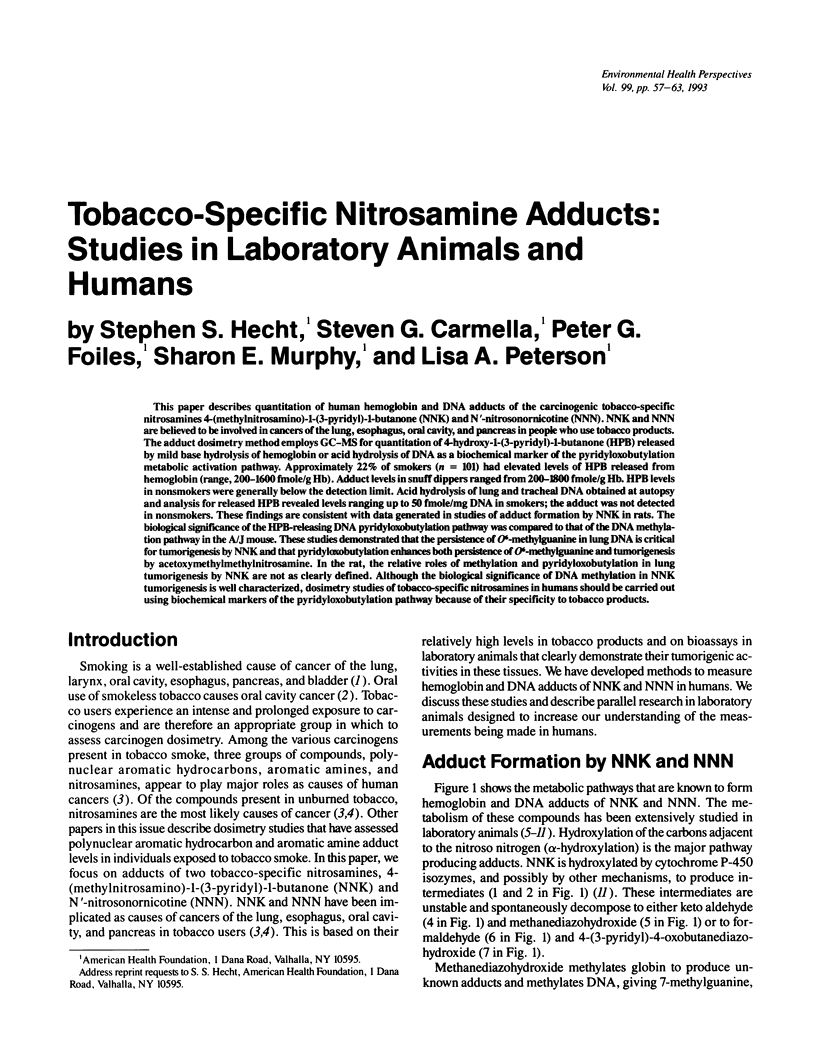
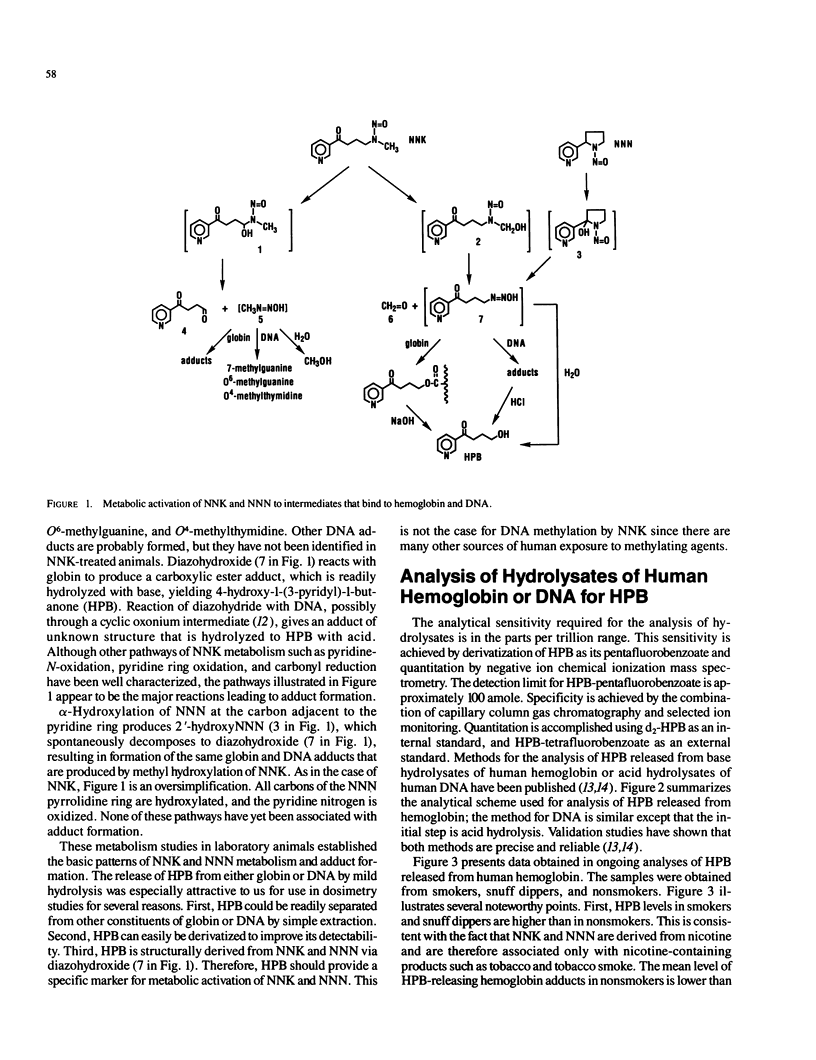
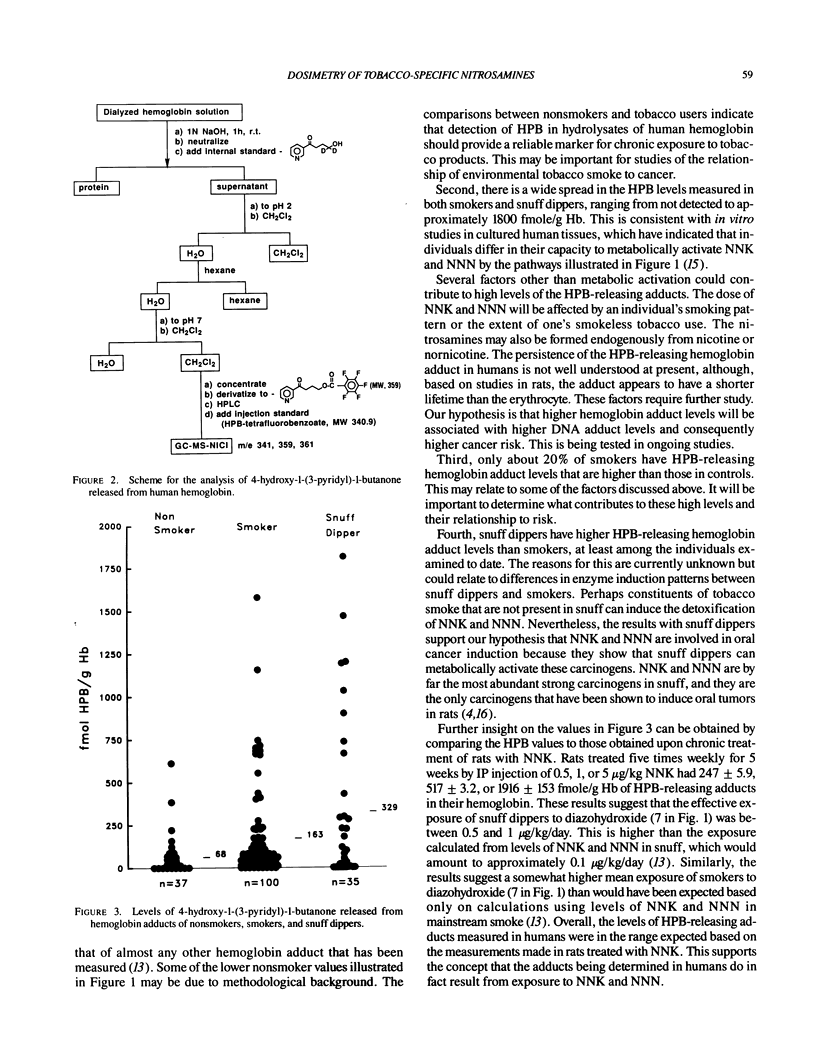
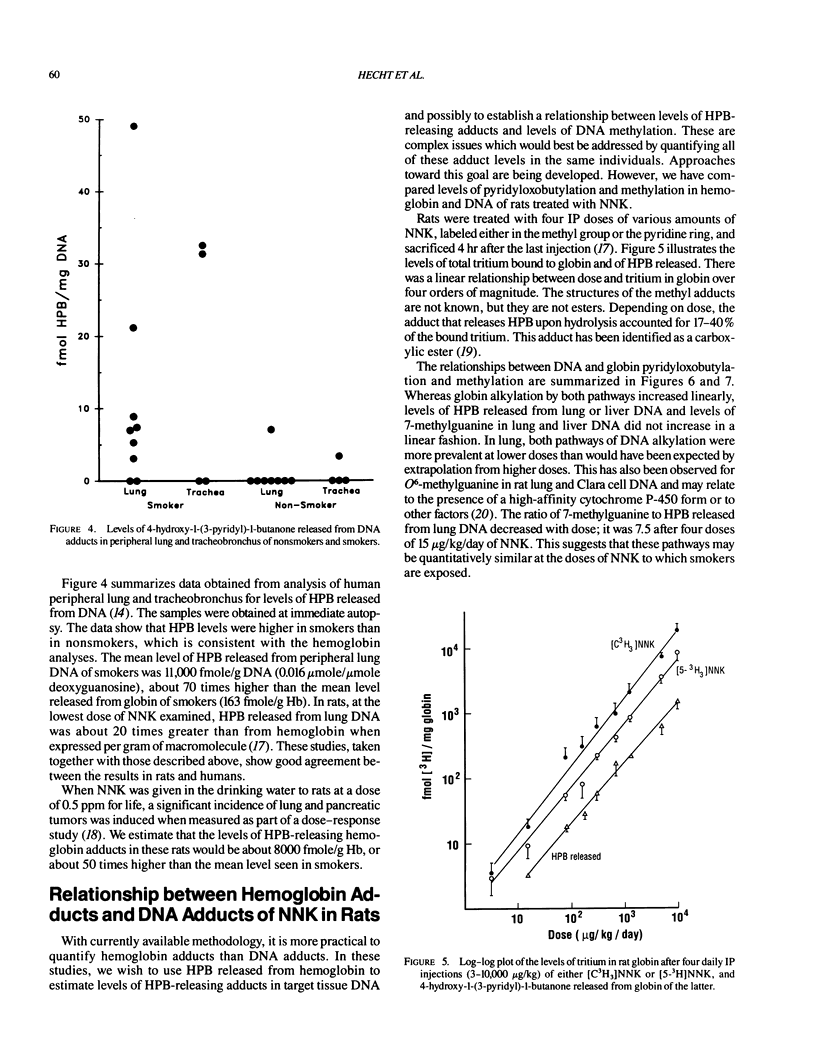
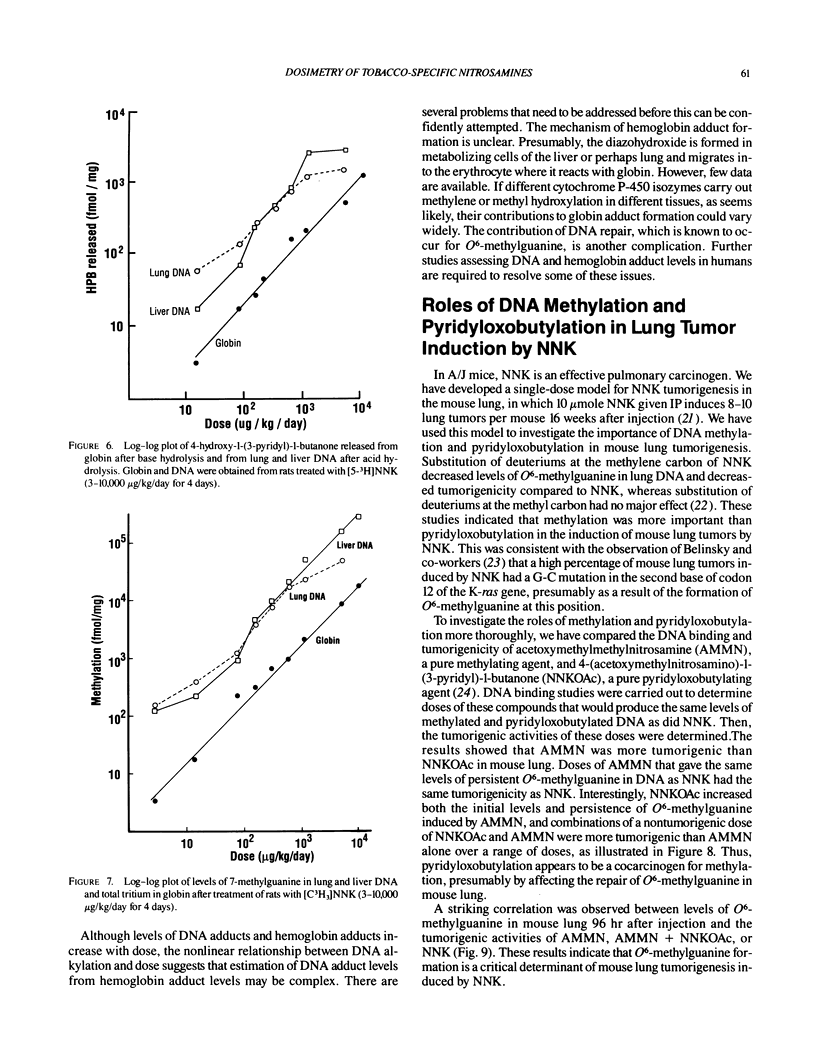
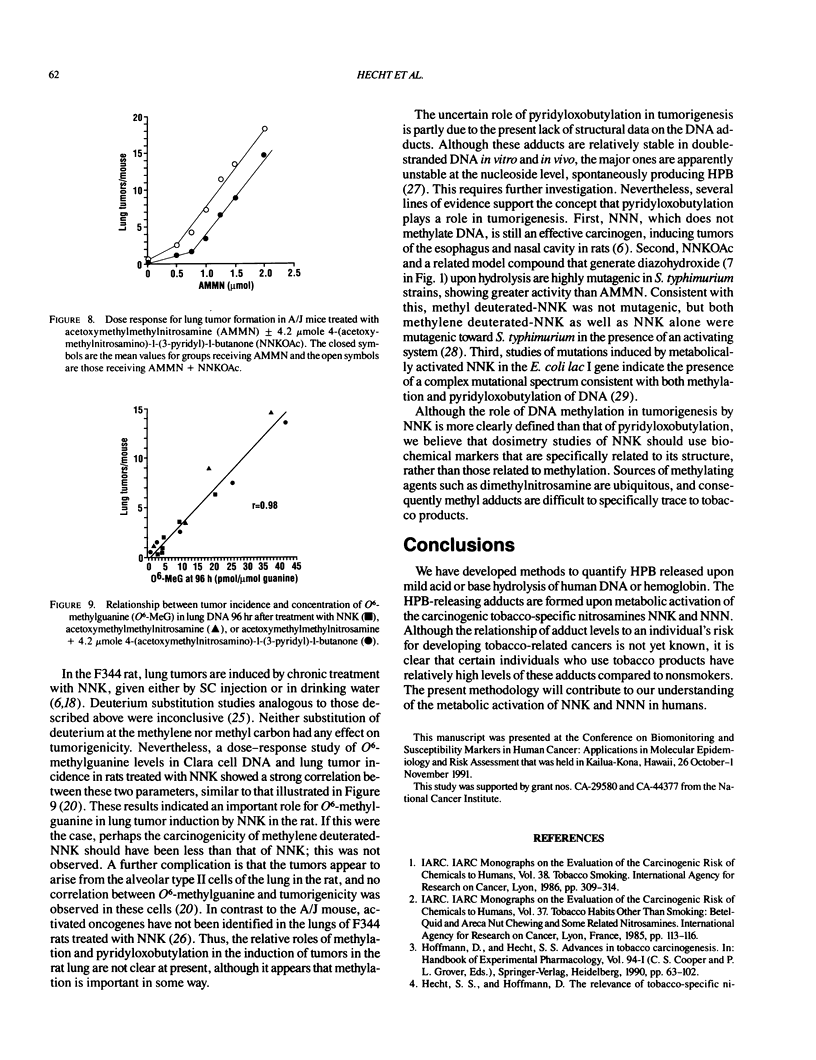
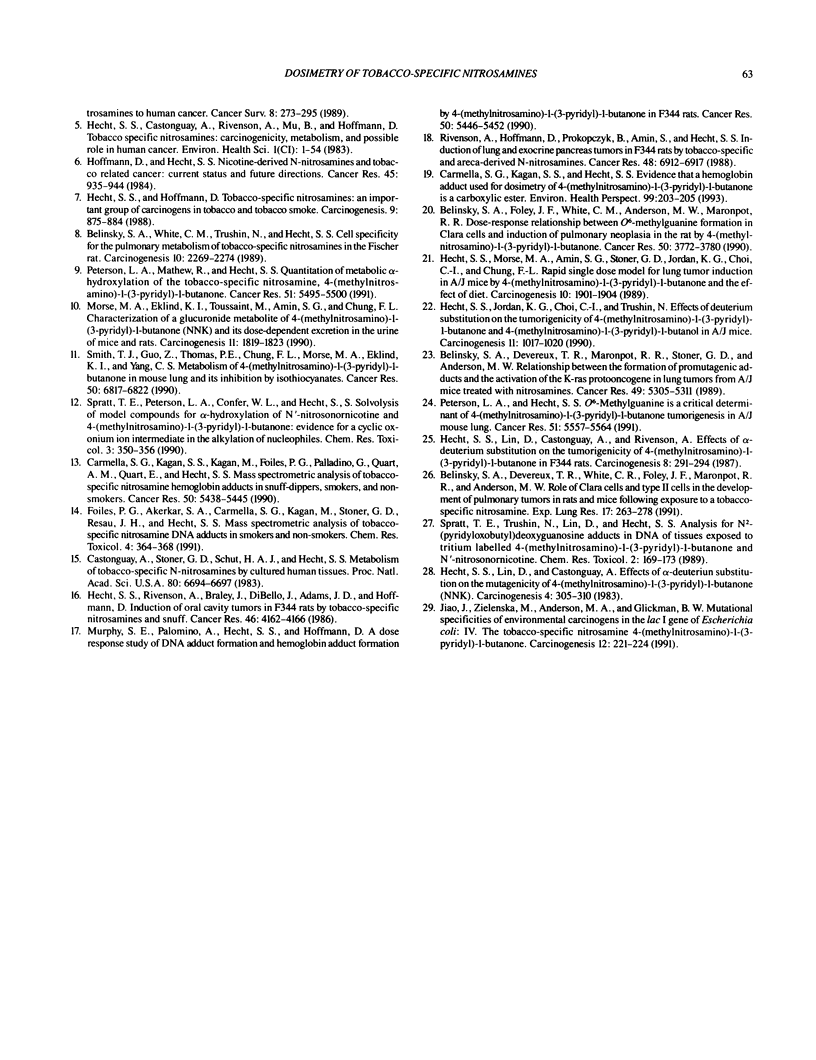
Selected References
These references are in PubMed. This may not be the complete list of references from this article.
- Belinsky S. A., Devereux T. R., Maronpot R. R., Stoner G. D., Anderson M. W. Relationship between the formation of promutagenic adducts and the activation of the K-ras protooncogene in lung tumors from A/J mice treated with nitrosamines. Cancer Res. 1989 Oct 1;49(19):5305–5311. [PubMed] [Google Scholar]
- Belinsky S. A., Devereux T. R., White C. M., Foley J. F., Maronpot R. R., Anderson M. W. Role of Clara cells and type II cells in the development of pulmonary tumors in rats and mice following exposure to a tobacco-specific nitrosamine. Exp Lung Res. 1991 Mar-Apr;17(2):263–278. doi: 10.3109/01902149109064417. [DOI] [PubMed] [Google Scholar]
- Belinsky S. A., Foley J. F., White C. M., Anderson M. W., Maronpot R. R. Dose-response relationship between O6-methylguanine formation in Clara cells and induction of pulmonary neoplasia in the rat by 4-(methylnitrosamino)-1-(3-pyridyl)-1-butanone. Cancer Res. 1990 Jun 15;50(12):3772–3780. [PubMed] [Google Scholar]
- Belinsky S. A., White C. M., Trushin N., Hecht S. S. Cell specificity for the pulmonary metabolism of tobacco-specific nitrosamines in the Fischer rat. Carcinogenesis. 1989 Dec;10(12):2269–2274. doi: 10.1093/carcin/10.12.2269. [DOI] [PubMed] [Google Scholar]
- Carmella S. G., Kagan S. S., Hecht S. S. Evidence that a hemoglobin adduct used for dosimetry of 4-(methylnitrosamino)-1-(3-pyridyl)-1-butanone is a carboxylic ester. Environ Health Perspect. 1993 Mar;99:203–205. doi: 10.1289/ehp.9399203. [DOI] [PMC free article] [PubMed] [Google Scholar]
- Carmella S. G., Kagan S. S., Kagan M., Foiles P. G., Palladino G., Quart A. M., Quart E., Hecht S. S. Mass spectrometric analysis of tobacco-specific nitrosamine hemoglobin adducts in snuff dippers, smokers, and nonsmokers. Cancer Res. 1990 Sep 1;50(17):5438–5445. [PubMed] [Google Scholar]
- Castonguay A., Stoner G. D., Schut H. A., Hecht S. S. Metabolism of tobacco-specific N-nitrosamines by cultured human tissues. Proc Natl Acad Sci U S A. 1983 Nov;80(21):6694–6697. doi: 10.1073/pnas.80.21.6694. [DOI] [PMC free article] [PubMed] [Google Scholar]
- Foiles P. G., Akerkar S. A., Carmella S. G., Kagan M., Stoner G. D., Resau J. H., Hecht S. S. Mass spectrometric analysis of tobacco-specific nitrosamine-DNA adducts in smokers and nonsmokers. Chem Res Toxicol. 1991 May-Jun;4(3):364–368. doi: 10.1021/tx00021a017. [DOI] [PubMed] [Google Scholar]
- Hecht S. S., Hoffmann D. The relevance of tobacco-specific nitrosamines to human cancer. Cancer Surv. 1989;8(2):273–294. [PubMed] [Google Scholar]
- Hecht S. S., Hoffmann D. Tobacco-specific nitrosamines, an important group of carcinogens in tobacco and tobacco smoke. Carcinogenesis. 1988 Jun;9(6):875–884. doi: 10.1093/carcin/9.6.875. [DOI] [PubMed] [Google Scholar]
- Hecht S. S., Jordan K. G., Choi C. I., Trushin N. Effects of deuterium substitution on the tumorigenicity of 4-(methylnitrosamino)-1-(3-pyridyl)-1-butanone and 4-(methylnitrosamino)-1-(3-pyridyl)-1-butanol in A/J mice. Carcinogenesis. 1990 Jun;11(6):1017–1020. doi: 10.1093/carcin/11.6.1017. [DOI] [PubMed] [Google Scholar]
- Hecht S. S., Lin D., Castonguay A. Effects of alpha-deuterium substitution on the mutagenicity of 4-(methyl-nitrosamino)-1-(3-pyridyl)-1-butanone (NNK). Carcinogenesis. 1983;4(3):305–310. doi: 10.1093/carcin/4.3.305. [DOI] [PubMed] [Google Scholar]
- Hecht S. S., Lin D., Castonguay A., Rivenson A. Effects of alpha-deuterium substitution on the tumorigenicity of 4-(methylnitrosamino)-1-(3-pyridyl)-1-butanone in F344 rats. Carcinogenesis. 1987 Feb;8(2):291–294. doi: 10.1093/carcin/8.2.291. [DOI] [PubMed] [Google Scholar]
- Hecht S. S., Morse M. A., Amin S., Stoner G. D., Jordan K. G., Choi C. I., Chung F. L. Rapid single-dose model for lung tumor induction in A/J mice by 4-(methylnitrosamino)-1-(3-pyridyl)-1-butanone and the effect of diet. Carcinogenesis. 1989 Oct;10(10):1901–1904. doi: 10.1093/carcin/10.10.1901. [DOI] [PubMed] [Google Scholar]
- Hecht S. S., Rivenson A., Braley J., DiBello J., Adams J. D., Hoffmann D. Induction of oral cavity tumors in F344 rats by tobacco-specific nitrosamines and snuff. Cancer Res. 1986 Aug;46(8):4162–4166. [PubMed] [Google Scholar]
- Hoffmann D., Hecht S. S. Nicotine-derived N-nitrosamines and tobacco-related cancer: current status and future directions. Cancer Res. 1985 Mar;45(3):935–944. [PubMed] [Google Scholar]
- Jiao J. L., Zielenska M., Anderson M. W., Glickman B. W. Mutational specificities of environmental carcinogens in the lacI gene of Escherichia coli: IV. The tobacco-specific nitrosamine 4-(methylnitrosamino)-1-(3-pyridyl)-1-butanone. Carcinogenesis. 1991 Feb;12(2):221–224. doi: 10.1093/carcin/12.2.221. [DOI] [PubMed] [Google Scholar]
- Morse M. A., Eklind K. I., Toussaint M., Amin S. G., Chung F. L. Characterization of a glucuronide metabolite of 4-(methyl-nitrosamino)-1-(3-pyridyl)-1-butanone (NNK) and its dose-dependent excretion in the urine of mice and rats. Carcinogenesis. 1990 Oct;11(10):1819–1823. doi: 10.1093/carcin/11.10.1819. [DOI] [PubMed] [Google Scholar]
- Murphy S. E., Palomino A., Hecht S. S., Hoffmann D. Dose-response study of DNA and hemoglobin adduct formation by 4-(methylnitrosamino)-1-(3-pyridyl)-1-butanone in F344 rats. Cancer Res. 1990 Sep 1;50(17):5446–5452. [PubMed] [Google Scholar]
- Peterson L. A., Hecht S. S. O6-methylguanine is a critical determinant of 4-(methylnitrosamino)-1-(3-pyridyl)-1-butanone tumorigenesis in A/J mouse lung. Cancer Res. 1991 Oct 15;51(20):5557–5564. [PubMed] [Google Scholar]
- Peterson L. A., Mathew R., Hecht S. S. Quantitation of microsomal alpha-hydroxylation of the tobacco-specific nitrosamine, 4-(methylnitrosamino)-1-(3-pyridyl)-1-butanone. Cancer Res. 1991 Oct 15;51(20):5495–5500. [PubMed] [Google Scholar]
- Rivenson A., Hoffmann D., Prokopczyk B., Amin S., Hecht S. S. Induction of lung and exocrine pancreas tumors in F344 rats by tobacco-specific and Areca-derived N-nitrosamines. Cancer Res. 1988 Dec 1;48(23):6912–6917. [PubMed] [Google Scholar]
- Smith T. J., Guo Z. Y., Thomas P. E., Chung F. L., Morse M. A., Elkind K., Yang C. S. Metabolism of 4-(methylnitrosamino)-1-(3-pyridyl)-1-butanone in mouse lung microsomes and its inhibition by isothiocyanates. Cancer Res. 1990 Nov 1;50(21):6817–6822. [PubMed] [Google Scholar]
- Spratt T. E., Peterson L. A., Confer W. L., Hecht S. S. Solvolysis of model compounds for alpha-hydroxylation of N'-nitrosonornicotine and 4-(methylnitrosamino)-1-(3-pyridyl)-1-butanone: evidence for a cyclic oxonium ion intermediate in the alkylation of nucleophiles. Chem Res Toxicol. 1990 Jul-Aug;3(4):350–356. doi: 10.1021/tx00016a013. [DOI] [PubMed] [Google Scholar]
- Spratt T. E., Trushin N., Lin D., Hecht S. S. Analysis for N2-(pyridyloxobutyl)deoxyguanosine adducts in DNA of tissues exposed to tritium-labeled 4-(methylnitrosamino)-1-(3-pyridyl)-1-butanone and N'-nitrosonornicotine. Chem Res Toxicol. 1989 May-Jun;2(3):169–173. doi: 10.1021/tx00009a008. [DOI] [PubMed] [Google Scholar]


